Reduced Erg Dosage Impairs Survival of Hematopoietic Stem and Progenitor Cells
- PMID: 28436588
- PMCID: PMC5532742
- DOI: 10.1002/stem.2627
Reduced Erg Dosage Impairs Survival of Hematopoietic Stem and Progenitor Cells
Abstract
ERG, an ETS family transcription factor frequently overexpressed in human leukemia, has been implicated as a key regulator of hematopoietic stem cells. However, how ERG controls normal hematopoiesis, particularly at the stem and progenitor cell level, and how it contributes to leukemogenesis remain incompletely understood. Using homologous recombination, we generated an Erg knockdown allele (Ergkd ) in which Erg expression can be conditionally restored by Cre recombinase. Ergkd/kd animals die at E10.5-E11.5 due to defects in endothelial and hematopoietic cells, but can be completely rescued by Tie2-Cre-mediated restoration of Erg in these cells. In Ergkd/+ mice, ∼40% reduction in Erg dosage perturbs both fetal liver and bone marrow hematopoiesis by reducing the numbers of Lin- Sca-1+ c-Kit+ (LSK) hematopoietic stem and progenitor cells (HSPCs) and megakaryocytic progenitors. By genetic mosaic analysis, we find that Erg-restored HSPCs outcompete Ergkd/+ HSPCs for contribution to adult hematopoiesis in vivo. This defect is in part due to increased apoptosis of HSPCs with reduced Erg dosage, a phenotype that becomes more drastic during 5-FU-induced stress hematopoiesis. Expression analysis reveals that reduced Erg expression leads to changes in expression of a subset of ERG target genes involved in regulating survival of HSPCs, including increased expression of a pro-apoptotic regulator Bcl2l11 (Bim) and reduced expression of Jun. Collectively, our data demonstrate that ERG controls survival of HSPCs, a property that may be used by leukemic cells. Stem Cells 2017;35:1773-1785.
Keywords: Animal models; Apoptosis; Hematopoietic progenitors; Hematopoietic stem cells; Leukemia; Transcription factors.
© 2017 AlphaMed Press.
Conflict of interest statement
The authors declare no competing financial interests.
Figures
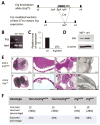

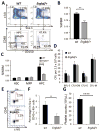
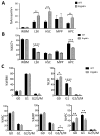
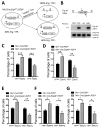
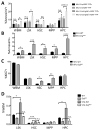
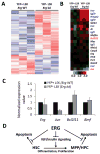
Similar articles
-
Nfix is a novel regulator of murine hematopoietic stem and progenitor cell survival.Blood. 2013 Oct 24;122(17):2987-96. doi: 10.1182/blood-2013-04-493973. Epub 2013 Sep 16. Blood. 2013. PMID: 24041575 Free PMC article.
-
Delineating the effects of 5-fluorouracil and follicle-stimulating hormone on mouse bone marrow stem/progenitor cells.Stem Cell Res Ther. 2016 Apr 19;7(1):59. doi: 10.1186/s13287-016-0311-6. Stem Cell Res Ther. 2016. PMID: 27095238 Free PMC article.
-
Checkpoint kinase 1 is essential for fetal and adult hematopoiesis.EMBO Rep. 2019 Aug;20(8):e47026. doi: 10.15252/embr.201847026. Epub 2019 Jun 17. EMBO Rep. 2019. PMID: 31379128 Free PMC article.
-
Osteogenic niche in the regulation of normal hematopoiesis and leukemogenesis.Haematologica. 2018 Dec;103(12):1945-1955. doi: 10.3324/haematol.2018.197004. Epub 2018 Oct 18. Haematologica. 2018. PMID: 30337364 Free PMC article. Review.
-
Hematopoietic Stem and Progenitor Cells (HSPCs).Adv Exp Med Biol. 2019;1201:49-77. doi: 10.1007/978-3-030-31206-0_3. Adv Exp Med Biol. 2019. PMID: 31898781 Review.
Cited by
-
Transcription factor genetics and biology in predisposition to bone marrow failure and hematological malignancy.Front Oncol. 2023 Jun 12;13:1183318. doi: 10.3389/fonc.2023.1183318. eCollection 2023. Front Oncol. 2023. PMID: 37377909 Free PMC article. Review.
-
Interplay of IGF1R and estrogen signaling regulates hematopoietic stem and progenitor cells.bioRxiv [Preprint]. 2024 Mar 21:2024.03.20.585808. doi: 10.1101/2024.03.20.585808. bioRxiv. 2024. PMID: 38562745 Free PMC article. Preprint.
-
Germ line ERG haploinsufficiency defines a new syndrome with cytopenia and hematological malignancy predisposition.Blood. 2024 Oct 24;144(17):1765-1780. doi: 10.1182/blood.2024024607. Blood. 2024. PMID: 38991192 Free PMC article.
-
Molecular Mechanisms of the Genetic Predisposition to Acute Megakaryoblastic Leukemia in Infants With Down Syndrome.Front Oncol. 2021 Mar 11;11:636633. doi: 10.3389/fonc.2021.636633. eCollection 2021. Front Oncol. 2021. PMID: 33777792 Free PMC article. Review.
-
The Eupentacta fraudatrix transcriptome provides insights into regulation of cell transdifferentiation.Sci Rep. 2020 Jan 30;10(1):1522. doi: 10.1038/s41598-020-58470-0. Sci Rep. 2020. PMID: 32001787 Free PMC article.
References
-
- Martens JH. Acute myeloid leukemia: a central role for the ETS factor ERG. Int J Biochem Cell Biol. 2011;43:1413–1416. - PubMed
-
- Tomlins SA, Rhodes DR, Perner S, et al. Recurrent fusion of TMPRSS2 and ETS transcription factor genes in prostate cancer. Science. 2005;310:644–648. - PubMed
-
- Ginsberg JP, de Alava E, Ladanyi M, et al. EWS-FLI1 and EWS-ERG gene fusions are associated with similar clinical phenotypes in Ewing’s sarcoma. J Clin Oncol. 1999;17:1809–1814. - PubMed
Publication types
MeSH terms
Substances
Grants and funding
LinkOut - more resources
Full Text Sources
Other Literature Sources
Medical
Molecular Biology Databases
Research Materials
Miscellaneous

